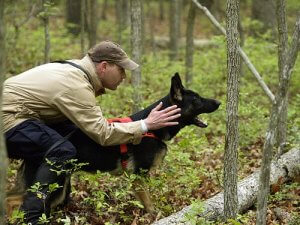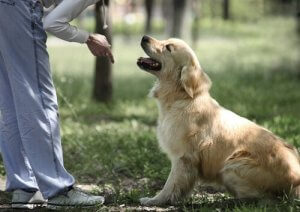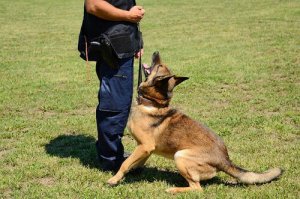The Importance of Canine Training and Education

The canine education industry has been booming over the past few years. At the same time, dog trainers continue to be a popular choice among owners. Today, we’ll tell you about the differences between the two, and the importance of canine training and education for our pets.
What is canine training?
In simple terms, a dog trainer is responsible for teaching dogs tricks and commands. This may be the basics, such as training a dog to sit or to not pull on the leash, or more complex tasks such as search and rescue training. They teach the animal to perform a task regardless of the situation. For example, a well-trained dog will “shake” whenever their owner gives the command.
This is because trainers teach dogs to follow orders. If you seek help from a trainer because your dog pulls on the leash, they will teach your dog to walk beside you, no matter what the situation, and whether your dog wants to or not. Even if your dog wants to run off, it won’t, because it will have learned to stay by your side.

Trainers work closely with the dogs rather than the owners. In the case of more complex training, the dog may even stay at special facilities for a while until the training is complete. The owners have little to do with the training itself; they simply repeat the commands their dog has learned from its trainer.
What is canine education?
Canine educators, on the other hand, teach the dog to behave without specific orders. They focus on the dog’s emotions and general behavior. If your pet pulls on the leash, the educator will teach them how to stay calm when outside the house so that they’ll stop pulling while out on a walk.
Rather than teaching commands, a canine educator works to resolve behavioral problems. If a dog displays aggressiveness towards other dogs, they find out the cause of the behavior, and tackle the root of the problem. Trainers, on the other hand, use commands to teach the dog not to react to other dogs. This could be seen as simply “masking” the underlying problem.
In order to understand their behavior, educators take the animal’s mental state and home life into account. They identify any possible sources of stress that may affect the dog on a day-to-day basis, and hinder the relationship between them and their owners.
Educators work more closely with the owners than they do with the dogs. Rather than bringing the dog to stay with them, educators work with the whole family in their home environment. They give the owners the tools to solve problems by themselves, and monitor their progress closely. Each case is very different, and the reeducation and treatment plan must be specially tailored to each individual.

The importance of canine training and education
Many canine experts tend to have knowledge of both training and educational techniques. They may choose to specialize in one more than the other, but no one is ever just a trainer or just an educator.
For example, a trainer can’t teach a dog to do agility if they have no idea how to manage their stress levels. The first thing they’ll do is try to understand their emotional state (just like an educator). Only then will they move on to teaching them the commands they need to do agility training.
Similarly, an educator may use specific commands to tackle behavioral issues. For example, if a dog has a habit of chasing cyclists, the educator may give them a series of commands to distract them momentarily, and stop them from chasing after them. However, they’ll only give these commands for a limited amount of time before changing their methods. Just giving orders is the job of a trainer.
The importance of both training and education in dogs lies in the ability to improve the relationship between owners and their pets. The best canine expert is one that understands the principles of both training and education. They should also be able to adapt their methodology to each individual case according to the needs of each family.
Finding the right professional for your dog
If your dog has behavioral issues, or you want to teach them to follow commands, seek help from a professional.
Some of the hallmarks of a good canine professional include:
- They will have publicized testimonials from former clients
- They don’t use punishments, choke collars, shock collars, or chains
- Their work is based on the latest research and scientific studies rather than old-fashioned dominance techniques
- They should listen to your needs and offer solutions that are specially tailored to you and your pet
- They have proof of formal training and accreditation
A good professional knows the importance of training and education, and uses both schools to help their clients to the best of their ability. They do their job without inflicting harm on the animals, or using scare tactics. If you think a trainer or educator may be abusing your dog, report it to the authorities, and go elsewhere.
The canine education industry has been booming over the past few years. At the same time, dog trainers continue to be a popular choice among owners. Today, we’ll tell you about the differences between the two, and the importance of canine training and education for our pets.
What is canine training?
In simple terms, a dog trainer is responsible for teaching dogs tricks and commands. This may be the basics, such as training a dog to sit or to not pull on the leash, or more complex tasks such as search and rescue training. They teach the animal to perform a task regardless of the situation. For example, a well-trained dog will “shake” whenever their owner gives the command.
This is because trainers teach dogs to follow orders. If you seek help from a trainer because your dog pulls on the leash, they will teach your dog to walk beside you, no matter what the situation, and whether your dog wants to or not. Even if your dog wants to run off, it won’t, because it will have learned to stay by your side.

Trainers work closely with the dogs rather than the owners. In the case of more complex training, the dog may even stay at special facilities for a while until the training is complete. The owners have little to do with the training itself; they simply repeat the commands their dog has learned from its trainer.
What is canine education?
Canine educators, on the other hand, teach the dog to behave without specific orders. They focus on the dog’s emotions and general behavior. If your pet pulls on the leash, the educator will teach them how to stay calm when outside the house so that they’ll stop pulling while out on a walk.
Rather than teaching commands, a canine educator works to resolve behavioral problems. If a dog displays aggressiveness towards other dogs, they find out the cause of the behavior, and tackle the root of the problem. Trainers, on the other hand, use commands to teach the dog not to react to other dogs. This could be seen as simply “masking” the underlying problem.
In order to understand their behavior, educators take the animal’s mental state and home life into account. They identify any possible sources of stress that may affect the dog on a day-to-day basis, and hinder the relationship between them and their owners.
Educators work more closely with the owners than they do with the dogs. Rather than bringing the dog to stay with them, educators work with the whole family in their home environment. They give the owners the tools to solve problems by themselves, and monitor their progress closely. Each case is very different, and the reeducation and treatment plan must be specially tailored to each individual.

The importance of canine training and education
Many canine experts tend to have knowledge of both training and educational techniques. They may choose to specialize in one more than the other, but no one is ever just a trainer or just an educator.
For example, a trainer can’t teach a dog to do agility if they have no idea how to manage their stress levels. The first thing they’ll do is try to understand their emotional state (just like an educator). Only then will they move on to teaching them the commands they need to do agility training.
Similarly, an educator may use specific commands to tackle behavioral issues. For example, if a dog has a habit of chasing cyclists, the educator may give them a series of commands to distract them momentarily, and stop them from chasing after them. However, they’ll only give these commands for a limited amount of time before changing their methods. Just giving orders is the job of a trainer.
The importance of both training and education in dogs lies in the ability to improve the relationship between owners and their pets. The best canine expert is one that understands the principles of both training and education. They should also be able to adapt their methodology to each individual case according to the needs of each family.
Finding the right professional for your dog
If your dog has behavioral issues, or you want to teach them to follow commands, seek help from a professional.
Some of the hallmarks of a good canine professional include:
- They will have publicized testimonials from former clients
- They don’t use punishments, choke collars, shock collars, or chains
- Their work is based on the latest research and scientific studies rather than old-fashioned dominance techniques
- They should listen to your needs and offer solutions that are specially tailored to you and your pet
- They have proof of formal training and accreditation
A good professional knows the importance of training and education, and uses both schools to help their clients to the best of their ability. They do their job without inflicting harm on the animals, or using scare tactics. If you think a trainer or educator may be abusing your dog, report it to the authorities, and go elsewhere.
This text is provided for informational purposes only and does not replace consultation with a professional. If in doubt, consult your specialist.








